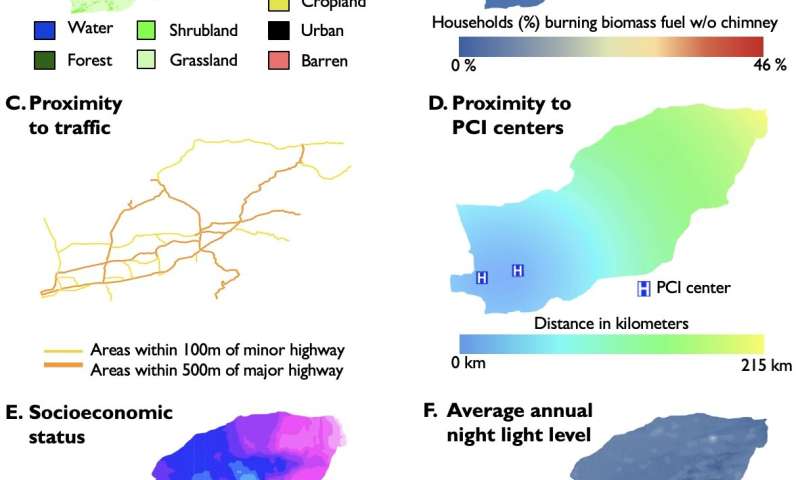Environmental factors predict risk of death: study

Along with high blood pressure, diabetes, and smoking, environmental factors such as air pollution are highly predictive of people's chances of dying, especially from heart attack and stroke, a new study shows.
Led by researchers at NYU Grossman School of Medicine and the Icahn School of Medicine at Mount Sinai, the study showed that exposure to above average levels of outdoor air pollution increased risk of death by 20%, and risk of death from cardiovascular disease by 17%.
Using wood- or kerosene-burning stoves, not properly ventilated through a chimney, to cook food or heat the home also increasd overall risk of death (by 23% and 9%) and cardiovascular death risk (by 36% and 19%). Living far from specialty medical clinics and near busy roads also increased risk of death.
Publishing in the journal PLOS ONE online June 24, the findings come from personal and environmental health data collected from 50,045 mostly poor, rural villagers living in the northeast Golestan region of Iran. All study participants were over age 40 and agreed to have their health monitored during annual visits with researchers dating as far back as 2004.

Researchers say their latest investigation not only identifies environmental factors that pose the greatest risk to heart and overall health, but also adds much-needed scientific evidence from people in low- and middle-income countries. Traditional research on environmental risk factors, the researchers note, has favored urban populations in high-income countries with much greater access to modern health care services.
Compared with those who have easier access to specialized medical services, those living farther away from clinics with catheterization labs able to unblock clogged arteries, for example, were at increased risk of death by 1% for every 10 kilometers (6.2 miles) of distance. In Golestan, most people live more than 50 miles (80 kilometers) away from such modern facilities.
Study results also showed that the one-third of study participants who lived within 500 meters (1,640 feet) of a major roadway had a 13% increased risk of death.
"Our study highlights the role that key environmental factors of indoor/outdoor air pollution, access to modern health services, and proximity to noisy, polluted roadways play in all causes of death and deaths from cardiovascular disease in particular," says study senior author and cardiologist Rajesh Vedanthan, MD, MPH.
"Our findings help broaden the disease-risk profile beyond age and traditional personal risk factors," says Vedanthan, an associate professor in the Department of Population Health and the Department of Medicine at NYU Langone Health.
"These results illustrate a new opportunity for health policymakers to reduce the burden of disease in their communities by mitigating the impact of environmental risk factors like air pollution on cardiovascular health," says study lead author Michael Hadley, MD, a fellow in cardiology and incoming assistant professor of medicine at Mount Sinai.
By contrast, the study showed that other environmental factors included in the analysis—low neighborhood income levels, increased population density, and too much nighttime light exposure—were not independent predictors of risk of death, despite previous research in mostly urban settings suggesting otherwise.
For the investigation, researchers analyzed data gathered through December 2018. They then created a predictive model on overall death risk and death risk from cardiovascular disease.
The research team plans to continue its analysis and hopes to apply the predictive model to other countries with the aim of fine-tuning its predictive capacity. They say their new tool could serve as a guide for evaluating the effectiveness of environmental, lifestyle, and personal health changes in reducing mortality rates worldwide.
According to the World Health Organization, one-quarter of all deaths worldwide are now attributable to environmental factors, including poor air and water quality, lack of sanitation, and exposure to toxic chemicals. Household air pollution linked to higher risk of heart attacks, death
More information: Spatial environmental factors predict cardiovascular and all-cause mortality: Results of the SPACE Study, PLoS ONE (2022).
Journal information: PLoS ONE
Provided by NYU Langone Health
No comments:
Post a Comment